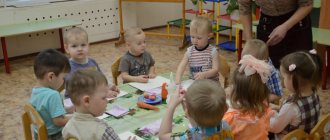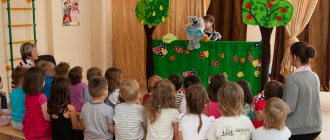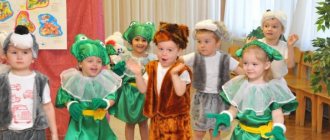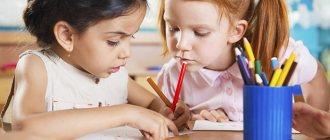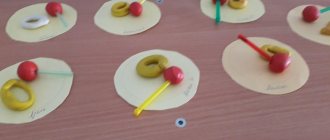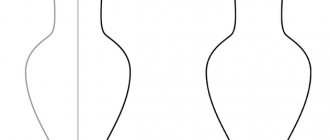The importance of mathematics classes in the younger group
Such classes are also called FEMP. The abbreviation is derived from the first letters of the full name of the process. This completely sounds like the formation of elementary mathematical concepts.
Lesson in kindergarten
According to the Federal State Educational Standard, the 2nd junior group receives FEMP classes for the first time in the garden. With age, the number and duration of classes increase. Mathematical activities stimulate a child's brain activity and intelligence. They also contribute to the development of thinking and memory, and develop a tendency to learn about a subject, for example, why vehicles move.
With it you can gain basic, simple knowledge of mathematics. For example, figure and form, properties and time, length, width and height. To make it interesting for the preschooler, classes are conducted in a playful manner, take a didactic bent, and are intelligently intertwined with leisure time.
For your information! As concomitant successes, the child learns perseverance during classes, patience is cultivated, processes that form imagination and attentiveness are involved.
Studying a subject in younger groups gives great guarantees that the child will do well at school, of course, provided that he is really interested in the classes. Positive achievements provide motivation to further study the subject at school. The absence of pronounced pressure when studying a subject helps the child develop while having fun.
Game form of classes
Asks children to be careful, attentive and follow all actions according to instructions- Our path is not close,
We will travel by train. Each of you will be the driver of your own train. You choose the route yourself and move to the music. As soon as the music stops and you hear the name of the station, you need to immediately rush to the named station.
Asks the children to pick up a picture of a train. Music is playing.
— Red Square station.
Invites the children to take their seats (everyone is seated on chairs) and pays attention to their posture.
The teacher says a word and throws a ball to one of the children; The child must catch the ball, say the word with the opposite meaning, and throw the ball again to the teacher.
Back and forth,
up down,
far close,
high - low,
big small,
loud quiet.
- You completed this task, although it was difficult.
Offers to do a warm-up.
- I see that your arms, legs, eyes are tired. Let's do a warm-up.
Mouth, nose, head,
Ears, cheeks, forehead, eyes, (we just show ourselves with our own hands)
Shoulders, upper arms, neck, chest (we clap on the shoulders, stroke the neck and tap the chest with our fingers)
Don’t forget something (we spread our arms to the sides)
Hands-hands - clap-clap, (clap your hands with your hands)
Feet-feet - stomp-stomp, (also stamp your feet)
Once here and once there (turns head left and right)
This is no, but this is yes. (head gestures “no” and “yes”)
Asks the children to pick up a picture of a train and hit the road.
— We get on the train and hit the road.
Music is playing.
— Green Triangle station.
- Look, guys, there's someone here. Who is this? (two teddy bears of different sizes).
— Are the bear cubs the same size?
- Show me the big bear.
—What size is the second bear?
He offers to sit next to the cubs on the carpet.
- Guys, look how the cubs are thinking. Mother bear asked big Mishutka to put the big cubes into a box, and little Mishutka to put the small cubes into another box, but this task turned out to be difficult for the cubs. Let's help them.
Asks the children to pick up a picture of a train and hit the road.
— We get on the train and hit the road.
Music is playing.
— Blue Circle station.
— We traveled a lot and did not notice how evening came. What time of day comes after evening? Each of us has to occupy some kind of house. And they are all different. So that you know which one to check in, I will give you a document of the same color. (distributes squares of different colors) Glues “roofs” of different colors onto the chairs.
— When it’s day and the sun is shining, the children go out and walk. And when it’s night, they quickly run to their house.
At the signal “night” the children occupy the “houses”. The teacher checks the documents. The game is played several times, the teacher changes the location of the houses.
— The night passed quickly. It's time for us to hit the road again.
Asks the children to pick up a picture of a train and hit the road.
— We get on the train and hit the road.
Music is playing.
— Yellow Oval station.
He asks you to stand around the table, on which there are two plates. There are pictures on them.
They are divided into two parts: geometric shapes, images of various objects. Select objects to match the geometric figure, explaining your choice: - - The Christmas tree looks like a triangle, it is triangular in shape.
The game continues until all items are matched to the samples.
- Guys, let's look around and find objects that look like a square, a triangle, a circle.
Draws attention to the large white ball.
- Guys, look, it seems to me that this is not just a ball, but a ball with a surprise. How do we know this? Let's close our eyes and count out loud to 5.
The ball bursts and candy and small balls fall out of it. Among them is a hint where the gifts from the Mathematics Fairy are located.
Asks the children to pick up a picture of a train and hit the road.
— We get on the train and go to our kindergarten..
Methodology for conducting GCD in mathematics in early preschool age
An important rule that guarantees results is to conduct classes not only in the kindergarten group. At home, the child must also develop and study with his parents.
Important! After home lessons, the child may want to brag about his successes to his family. In this case, the baby should receive a portion of admiration from praise.
When the first math lesson is held in the second junior group, the children are divided into small teams. This division lasts only a month, then they all study together. This is due to the fact that such an exact science is still quite difficult for children.
Senior groups immediately begin general classes, starting in September. The duration of classes depends on the group. In younger groups, lessons last 15 minutes. The time gradually increases to half an hour in older groups. An event that takes too long, even in its lightest form, will tire even the older guys.
The lessons themselves are held before lunch, when concentration is not greatly reduced. To relax, a subject that requires mental stress alternates with active games or physical exercises.
For your information! The FEMP program is carried out from September to May, then knowledge is supported in a game-based didactic form. There are no classes during the summer.
The volume of study is no more than 1 topic per lesson. The child's brain should not be overloaded. For example, in one lesson a child gets acquainted with the shape of a square, in the next with a circle, and only then a triangle is studied. Classes are held on a weekly basis.
Lesson at home with parents
Summary of the lesson on FEMP in the 1st junior group “Let's play with nesting dolls”
Urban district city of Vyksa
MUNICIPAL BUDGETARY PRESCHOOL EDUCATIONAL INSTITUTION
Combined kindergarten No. 7 “Goldfish”
607060, Vyksa, st. Kornilova building 97, 8(83177)3-55-11,
Lesson notes
on Formation of elementary mathematical concepts
in 1st junior group
"Let's play with nesting dolls"
Performed:
Gorchitsyna Valeria Eduardovna
Lesson No. 3, p. 19 I.A. Pomoraeva, V.A. Pozina
Goals:
Development of the ability to form groups of homogeneous objects, distinguish the number of objects: many - one.
Materials and equipment
: large nesting dolls, small nesting dolls according to the number of children.
Progress of the lesson
The teacher brings in a box with identical nesting dolls, covered with a napkin. Then he takes off the napkin and says:
"We are funny nesting dolls
We love to run on the track.
We love to sing and dance
And play with the kids"
Educator:
Look, guys, we have guests today. Who are these guys?
Children's choral response
:
Matryoshka dolls.
Educator:
How many are there?
(The teacher offers to repeat the answer to the question to the children one by one. For example, Anya, how many nesting dolls? Timofey, how many nesting dolls came to visit us? Etc.)
Children:
A lot of.
Educator:
The nesting dolls want to play hide and seek with us. Look, I hid one nesting doll in my palms. Guys, how many nesting dolls did I hide?
(The teacher invites all children to answer this question. For example, Maxim, how many nesting dolls did I hide? Arisha, tell me, how many nesting dolls did I hide? Etc.)
Children:
One.
Educator
:
And now, Anton, hide one nesting doll in your palms.
The child takes one matryoshka doll from the table and hides it in his hands.
Guys, how many nesting dolls did Anton hide?
Children:
One.
Educator:
Nastya, hide one nesting doll. How many nesting dolls did Nastya hide?
Children:
One.
Educator:
Guys, each of you hid one nesting doll in your palms. Look how many nesting dolls are left on the table?
Children:
None.
Knock on the door (knock-knock-knock).
Educator:
Who came there? (shows the children a large matryoshka doll). This mother is a matryoshka doll, she lost her children. Don’t worry, mom is a nesting doll, here’s one of your nesting dolls (puts out the small one that was in her hand next to the big nesting doll). Sasha, how many nesting dolls do you have?
Sasha
:
One (puts it next to a large matryoshka doll).
All children perform this action in turn.
Physical education minute:
The teacher reads the words, the children repeat and perform the movements after the teacher:
Techniques for forming mathematical representations
To form ideas, special preparation is carried out. The main technique that is used in almost all activities is play. This is important for a preschooler. In addition, the teacher can use additional methods:
- oral-verbal;
- visual;
- practice.
When does a child begin to understand what is being said to him?
Methods are selected depending on the end goal or task. Also, when selecting, the characteristics of the group of children are taken into account. The chosen methodology also depends on the topic. Some methods are suitable for some topics, and others are suitable for others. It is common to mix methods. Game methods can be subject-oriented, plot-oriented or follow a script.
Important! The best results come from practice and playful learning. To do this, objects and actions with them are used. Visual memory develops.
The form for submitting assignments can be any. If necessary, the teacher can choose an individual form. An exercise to consolidate knowledge is selected based on the topic being studied. In most cases, group work is used, as it saves the teacher’s time, teaches kids cohesion and the ability to work in a team, which is a positive thing.
When using the game method, tasks should develop mathematical thinking and teach the child to master the data obtained in previous games. Games make it easy to explain space and size, colors, sizes.
It is recommended to reserve the visual method for those cases when you need to explain a topic that is easily demonstrated. For example, the lesson is about length and height. Visually, the child will immediately be able to distinguish long or short, tall or short. Concepts such as “left”, “right” and “center” require mandatory demonstration.
Division into groups
Of the oral methods, the most popular are explanations or instructions. The task is given orally. The child learns to listen to the teacher. Auditory memory and imagination develop. At the same time, information must be presented in portions. If too much is said verbally, the baby will not remember and will lose interest in the process.
To consolidate, one of the verbal forms is used - questions. Only by asking the child and listening to his answer, you can conclude whether he understood the topic or not. This method helps develop speech and communication skills. Each time the preschooler will answer faster and more correctly.
Note! A small quick survey is conducted at the end of each lesson. If the child does not understand, you should have a conversation and convey the necessary information to the child.
Mathematics in the younger group. Lesson notes on FEMP in the 2nd junior group
Program content:
- teach children to distinguish and correctly name a circle, square, triangle;
- teach to examine the shape of figures using touch and vision; group objects by shape;
- consolidate the ability to identify objects and groups of objects;
- distinguish between concepts many, one at a time, none;
- learn to listen to the teacher’s instructions and explanations, reproduce what is shown and do what is suggested to him.
Demo material:
- funny figures - men,
- circle,
- square,
- triangle,
- flannelograph,
- bear toy,
- square,
- triangle.
Handout:
- each of the children has a circle,
- square,
- a triangle of different colors and berries according to the number of children.
Progress of the lesson
Guys, I am pleased to see you smiling, joyful, listen: You look at me, you look at me, you look at him, Look at all of us. Everyone in our city is friends You couldn’t find a friendlier friend, And everyone should know us.
Funny figures came to us today - little men. Look how unusual they are. We are familiar with two figures - little men. Did you recognize them? What is the name of the figure? ( Square ).
Sasha, say hello to this little figure. What color is it? Show your squares. Lenya, what color is your square? And what color is Ira’s? ( Children answer )
Let's trace the square with our fingers! We move our finger straight: this is a corner, we turn the finger, another corner, we turn it again... Dima, what did you circle? — Square Now we draw a square in the air. Children, tell me, does the square roll? ( The square does not roll, the corners interfere with it ).
Our round little man is tired of waiting and wants us to play with him. Tell me, what color is the circle? Take your circles and place them in front of you. Masha, what color is your circle? What about Anya? Let's draw a circle with our finger. The finger runs, runs in a circle, where it left and returned. We draw a circle in the air. Can a circle roll? — It’s rolling around, it has no corners .
We don’t know this little man and we’ll get to know him now. This is a triangle.
Let's all say it together: triangle. What colour is he? Show me all your triangles. What color is Valera's triangle? What about Maxim? Let's trace a triangle with our finger.
The finger rolled down the hill, a corner, we move the finger, we lead, again the corner, and the finger went up the hill. Let's draw a triangle in the air. What shapes did we circle? Let's say it together: triangle. What does a triangle look like? (On the roof, on the gusset, on the hill) .
Children, try rolling the triangle or not? That's right, don't roll, the corners are in the way. Funny figures - little men want them to have many friends, each little man takes a friend, just like himself, i.e. a circle only takes a circle as friends, a square is squares, a triangle is triangles.
Fizminutka
The bear wants to play with you guys. A clumsy bear walks through the forest, collects cones and puts them in his pocket, a cone fell right on Mishka’s forehead, Mishka got angry and stamped his foot.
Mishka told me guys that he wants to build a house for himself, but doesn’t know where to start. There are different figures in front of him, let's help him. What will we build the wall from? - From the square . The roof? - From a triangle . (The bear places it either from the side or from the bottom). Does this house have a roof? The roof of the house is not on the side or below, but at the top.
Now Mishka is not afraid of rain or cold in such a house. Children, look, the bear has berries in his basket and he wants to treat you with them. How many berries does Mishka have? - A lot of . How many children do you have? - A lot of . Come and take one berry. Masha, how many berries did you take? - One . Valera, how many berries did you take? - One . Mishke has fewer and fewer berries left. How many berries are left in the basket now? - None .
Thank the children to Mishka. Guys, let’s give the bear a gift too. This is a barrel of your favorite honey.
Progress of the lesson
At the preparatory stage, a lesson outline is drawn up and the necessary materials are prepared. If necessary, dummies are used. A selection of riddles, fairy tales and musical accompaniment is carried out in advance.
It is necessary to choose the form and methodology of conducting the lesson. For important topics, you can use an open lesson that will be attended by a guest. If parents of preschool children are invited as guests, the children will be more active.
A fairy tale or cartoon is chosen as the basis on which the game will be based. The chosen character should be loved by children and motivate them.
Mini blitz survey to consolidate knowledge
The teacher announces the essence and conditions of the game, passing off the character as the initiator of the game. Distributes necessary items or cards and all props. For example, if preschoolers are learning to count, then they are given counting sticks or other objects for counting. Riddles, stories and poems are designed to help make the task easier. Thanks to them, children will better understand the task.
“Repeat after me” - dance games to music for children from one to 5 years old
Important! After the main part, you can do physical exercises accompanied by music. After it, the children will relax and throw out the accumulated tension.
In conclusion, what has been learned is consolidated and the results are summed up. The guys need to say words of praise and emphasize that they are great. You can close the topic with the help of fairy tales, poems, music and songs.
Tips and tricks
Some techniques provide significant assistance with any chosen technique. They are used quite often in the learning process. Namely:
- comparative approach. Comparison gives the fastest possible result (one, two or many?). Any preschooler, barely looking, is able to give an answer;
- analyzing technique. Significantly develops thinking and cognition;
- generalization. Children learn to form groups as they learn;
- creation of models. Modeling is useful when certain concepts need to be developed. The method is useful and will help explain many things, from shapes and figures to the sun and stars;
- Pomoraev's geometric design method;
- Cuisenaire's rod counting method.
For your information! It is better to create combinations of techniques and methods for effective results.
Tasks and topics for teacher self-education on FEMP in the second junior group
The teacher must be fully proficient in the techniques and methods of FEMP. The piggy bank should contain both gaming and visual, verbal and other techniques. The final summary should include different forms of classes. The information should not be simple, complex or monotonous.
The main topics are:
- skills in using gaming and practical techniques when teaching children;
- orientation towards increasing the level of development of preschool children;
- checking and consolidating what was previously learned;
- analysis of completed work. Preparation of notes, study of literature.
For your information! The teacher must be able to compile a card index, prepare notes and a basis for conducting the lesson. It is required to be aware of all current literature in the field. Both scientific and psychological and pedagogical methods are used.
One way or another, the full formation of elementary mathematical concepts is impossible without the participation of parents. Only the joint work of the kindergarten staff and mom and dad will have an effect and will serve as the key to the child’s future success.
FEMP lesson in the second junior group “Magic Leaves”
Author of the lesson: teacher Dolgaya O. M., MBDOU “Kindergarten No. 80 “Rechenka”, Naberezhnye Chelny.
Target:
Development of children's mental abilities.
Program content:
Tasks:
1. Consolidate numbers from 1 to 5, count backwards from 5 to 1, develop counting skills within 5, consolidate knowledge about parts of the day, about colors, develop the skill of grouping figures by color and shape. 2. Develop children's creative abilities.
3. Cultivate the desire to complete the work started.
Vocabulary work:
Parts of the day.
Demo material:
Cards for charging, toys for counting, flannelgraph, diagram of a person.
Handout:
Beads of 5 pieces, cord, Gyönes blocks, simple pencils, counting sticks.
Lesson structure:
1. Game "Beads". 2. Stubborn children. 3. What's extra? 4. Charging using cards. 5. Find your color. 6. Lay out the little man. 7. Collect a butterfly.
8. Parts of the day.
Progress of the lesson:
Educator:
Guys! Today I came to kindergarten and saw leaves that were lying on the table. I was surprised! There was nothing here yesterday. Who brought the leaves? (Children's answers.)
Educator:
Right! Autumn brought these leaves. But the leaves are not simple, but with tasks. Autumn probably wants to know what we have learned. Shall we complete the tasks? Aren't you afraid of difficulties? Then let's get started!
Game "Beads"
We string as many beads onto the cord as I clap. Count how many toys, call the same number of beads. Remove 2 beads, how many are left? Count to 5, count back.
Game "Stubborn Children"
The teacher places his legs narrowly, and the children – widely. The teacher is close, and the children are far away, The teacher takes a step back, and the children - forward, Raises his left hand, and the children - the right, The ribbon is long, but the children say - short, The teacher walks, and the children run.
I say “quiet”, and the children say “loud”.
Game "What's extra"
Give everyone a sheet of paper with the task while the children think about laying out the Dienesh blocks.
Charging by cards
The teacher shows the cards, the children repeat the movements.
Find your color
A game is played with Dienesh blocks to classify objects by a certain color.
Counting sticks
Children need to make a figure of a man from counting sticks.
Game "Collect a butterfly"
On the chairs are the bodies of butterflies with different shapes. Children have wings with figures. Assemble the butterfly so that the shapes match.
